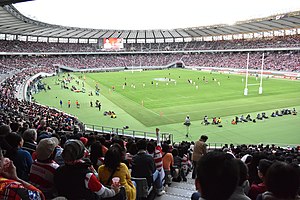Ajinomoto Stadium
Coordinates: 35°39′51.5″N 139°31′37.6″E / 35.664306°N 139.527111°E
Ajisuta | |
 | |
 | |
| Full name | Ajinomoto Stadium |
|---|---|
| Former names | Tokyo Stadium (2001–2003, 2019–2020) |
| Location | Chōfu, Tokyo, Japan |
| Public transit | |
| Owner | Tokyo Municipal Government |
| Operator | Tokyo Stadium Co.,Ltd. |
| Capacity | 49,970 |
| Field size | 110.5 m x 75.4 m |
| Surface | Grass |
| Opened | 10 March 2001 |
| Tenants | |
| |
Ajinomoto Stadium (味の素スタジアム, Ajinomoto Sutajiamu), also known as Tokyo Stadium in AFC Champions League, is a multi-purpose stadium in Chōfu, Tokyo, Japan. The stadium was founded at Kantō Mura, the redevelopment area formerly used by United States Forces Japan, in March 2001. It was the first stadium in Japan that offered its naming rights, which were sold to Ajinomoto Co., Inc. with a 5-year 1.2 billion yen (about 10 million U.S. dollars) contract, from March 2003 to February 2008. As a result, it was named Ajinomoto Stadium (味の素スタジアム, Ajinomoto Sutajiamu). This contract was renewed in November 2007 and extended by 6 years for 1.4 billion yen to February 2014, and in October 2013, the second renewal of the contract extended the term to February 2019.[1]
Overview[]



The stadium is the home of J1 League football club FC Tokyo and J2 League football club Tokyo Verdy and is used as the venue of some lower divisions of football leagues. Rugby union games are also held there. For the 2002 FIFA World Cup, Saudi Arabia's national team based their training camp at Chōfu and used the stadium as a main training ground, although it did not host an actual World Cup match.
The stadium is often used for non-sport events, such as concerts and flea markets. It has been used as a shelter for survivors of the 2011 Tōhoku earthquake and tsunami.[2] The stadium is the planned rugby venues for the 2020 Summer Olympics.[3] During the Olympics, the stadium will be known as Tokyo Stadium due to International Olympic Committee's non-commercialization policy. The stadium has also been one of the venues for 2019 Rugby World Cup and hosted the opening ceremony, followed by the opening match of the tournament, as well as other 7 matches including Bronze Final.[4]
Site[]
The north end of the stadium adjoins the Chofu Airport, while Route 20 runs close to the south end. At the south end is the main gate, which is directly connected by a pedestrian bridge over Route 20.
Stand[]
The stand accommodates 49,970 and is divided into two levels; the upper level accommodates 20,600 and the lower level 29,370 (both are all-seated). On each level, the stand is divided into four sections (main, back, north and south sides).
The whole of the upper level, as well as upper tiers of the lower level, is covered by roof, which is made of Teflon (main and back) and polycarbonate (both sides). The main stand houses media and hospitality boxes, VIP rooms and reception hall. Two large LED displays are installed at both sides.
Ground[]
The ground was originally designed for both athletics and football games. However, the construction of the supplementary ground, which is needed for compliance with 1st-grade athletic grounds in Japan, has been postponed. The management company has decided to use the ground mainly for football, and not to install a running track until the supplementary pitch has been added. Currently artificial turf is laid down all over the ground except the football field area, over which natural turf is spread. Consequently, there is some room between the football pitch and the stand.
In 2013, the athletics track was finally installed in order to host the National Sports Festival of Japan at the same year.[5] However, the artificial turf is still used over the track for football matches.
In order to comply with height limitation close to the airport, the pitch is sunk below the level of the land around the stadium.[citation needed]
2019 Rugby World Cup[]
| Date | Time (JST) | Team #1 | Res. | Team #2 | Round | Attendance |
|---|---|---|---|---|---|---|
| 20 September 2019 | 19:45 | 30–10 | Pool A (opening match) | 45,745 | ||
| 21 September 2019 | 16:15 | 23–21 | Pool C | 40,004 | ||
| 29 September 2019 | 16:45 | 25–29 | Pool D | 47,885 | ||
| 5 October 2019 | 17:00 | 39–10 | Pool C | 48,185 | ||
| 6 October 2019 | 13:45 | 71–9 | Pool B | 48,354 | ||
| 19 October 2019 | 19:15 | 46–14 | Quarter Final | 46,686 | ||
| 20 October 2019 | 19:15 | 3-26 | Quarter Final | 48,831 | ||
| 1 November 2019 | 18:00 | 40-17 | Bronze Final | 48,842 |
Access[]
References[]
- ^ "Frequently Asked Question". Tokyo Stadium (Japanese). Retrieved 2 December 2017.
- ^ People Magazine, April 4, 2011, p. 74
- ^ "Venue Plan". Tokyo 2020 Bid Committee. Archived from the original on 27 July 2013. Retrieved 11 September 2013.
- ^ "Yokohama Stadium to host 2019 Rugby World Cup Final". The Guardian. 28 September 2015. Retrieved 19 October 2015.
- ^ "Projects - Tokyo Stadium". Nihon Sekkei. Retrieved 22 April 2018.
It was constructed as the main stadium for the 2013 Tama National Games
External links[]
| Wikimedia Commons has media related to Ajinomoto Stadium. |
- Official website (in Japanese)
- Chōfu, Tokyo
- College football venues
- American football venues in Japan
- Football venues in Japan
- Rugby union stadiums in Japan
- Rugby in Kantō
- Sports venues in Tokyo
- Tokyo Verdy
- FC Tokyo
- Multi-purpose stadiums in Japan
- Venues of the 2020 Summer Olympics
- Sports venues completed in 2001
- 2001 establishments in Japan
- Olympic football venues
- Olympic rugby venues
- Olympic modern pentathlon venues




